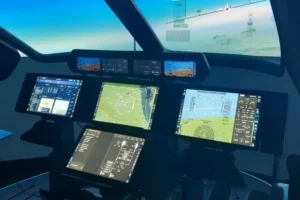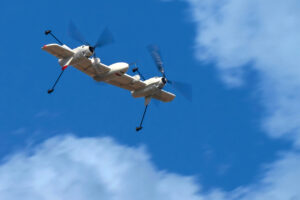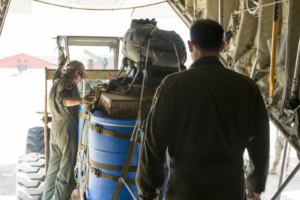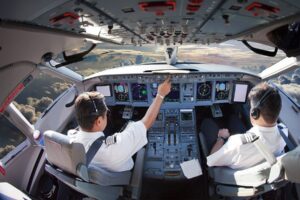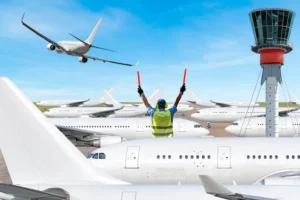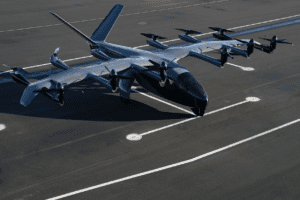World Economic Forum, City of Los Angeles Launch Working Group on Urban Air Mobility
By Brian Garrett-Glaser | November 26, 2019
Send Feedback

The World Economic Forum will partner with the city of Los Angeles and other stakeholders to explore a public policy roadmap for urban air mobility. Photo: Shutterstock
The World Economic Forum is partnering with the city of Los Angeles to launch a working group on urban air mobility, intending to explore the likely economic impacts of the new mode of transportation and other questions relevant to policymaking decisions. The working group held its first workshop on Nov. 15 as part of CoMotion LA 2019.
Initial founding members of the working group include Sikorsky and Skyryse, an urban air mobility company also working on autonomous helicopters, as well as the office of LA Mayor Eric Garcetti. More founding members, representing nonprofits, academia and other non-industry stakeholders, are expected to join as the working group launches, according to Harrison Wolf, project lead on aerospace and drones at WEF.
“We are hoping to dive into some of these more societally-focused challenges that policies will have to be put in place for, to really maximize the benefit to society while also mitigating the risk,” Wolf told Avionics International. “We’re really interested in making sure that this transportation mode is safe, clean, inclusive, equitable, and accessible to everyone.”
WEF chose to partner with the LA Mayor’s office for this project because of the city’s longstanding leadership on transportation, innovative leadership at the top, momentum from companies like Uber, which chose LA as one of its three pilot cities for Uber Air service as early as 2023.
“I would also say that LA is a unique geographic concept,” Wolf said. “Unlike many other localities where you have this very large urban sprawl, you have a number of communities that are sort of less segregated from one another in terms of distances. There’s also a topographical diversity where you have oceans, you’ve got mountainous regions that separate valleys … You also have a massively dense airspace with many airports serving the community and one of the most active airspaces in terms of first responders. I think that complexity provides a really interesting environment.”
The city of Los Angeles has engaged eight city departments to work on urban air mobility, including the departments of transportation and city planning. Working with WEF and other members of this working group, the city hopes to build a policy roadmap around urban air mobility including environmental impact, vehicle design, land use and economic and workforce development opportunity.
“In LA, we’re not ‘future-phobic’; we’re future-guiding,” Julia Thayne, associate director of mobility innovation for Mayor Eric Garcetti’s office, said in a WEF blog post published by Wolf. “We believe that Urban Aerial Mobility can be a meaningful part of our transportation network, but only if we work hand-in-hand with communities, companies, and cities across the world to ensure that outcomes are safe, secure, sustainable, and equitable.”
In that post, Wolf laid out some of the questions he plans for the working group to tackle:
- Will UAM be key to reducing congestion of people and packages on roads?
- Will it enable more people to access well-paid jobs from greater distances?
- Will this new mode of transit incentivize urban sprawl?
- Will it truly be accessible to all, regardless of income or neighborhood?
Sikorsky framed its participation in the working group as working with stakeholders to “develop a plan to inform policy, impacts and safeguards for UAM,” and to form an “action plan to develop sustainable, clean, inclusive and equitable policies.”
“Skyryse’s goal is to make urban air mobility accessible to everyone, and partnering with WEF gets us one step closer by bringing industry, local and federal groups together to ensure there is a broader look at the possibilities and applications of urban air mobility,” commented Brian Coulter, chief operating officer at Skyryse, which plans to launch urban air mobility services in Los Angeles soon. “WEF has a global perspective allowing us to think about solutions that have applicability worldwide. While we are starting in LA, our long-term vision is to make this transferable to any city across the globe.”
 | Don’t miss a beat on urban air mobility and eVTOL aircraft development. Sign up for our brand new e-letter, “The Skyport,” sent to inboxes every other Thursday with all the latest news, analysis and insider scoops. |
Notably absent from the initial founding members of the WEF-LA working group is Uber, which has faced criticism of its existing rideshare business for aggressive tactics with regards to city and state politics. Authorities at Transport for London recently decided not to extend Uber’s taxi operating license, citing persistent safety concerns.
“We have fundamentally changed our business over the last two years and are setting the standard on safety,” said Jamie Haywood, general manager for northern and eastern Europe in response to the decision. “TfL found us to be a fit and proper operator just two months ago, and we continue to go above and beyond. On behalf of the 3.5 million riders and 45,000 licensed drivers who depend on Uber in London, we will continue to operate as normal and will do everything we can to work with TfL to resolve this situation.”
A representative for Uber commented that it views the formation of the UAM working group is a “positive step” toward its aerial ridesharing vision, and Uber looks forward to participating.
Pamela Cohn, managing partner at Ascension Global, an advisory firm that works on urban air mobility, stressed that for this new, more intimate form of air transit to successfully integrate into communities, local authorities must be proactive rather than reactive in their policy planning and engage the right mix of stakeholders.
“The face of UAM is going to vary dramatically from community to community and local policy is going to be critical in making this new mobility mode work for our communities,” Cohn told Avionics International. “The WEF-LA City UAM Working Group has the potential to give us a concrete test case in charting what will be each community’s unique pathway to planning and integration.”


